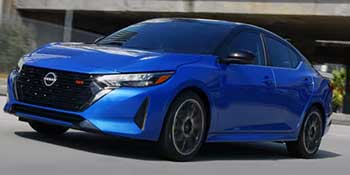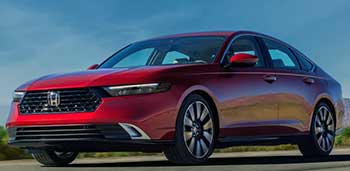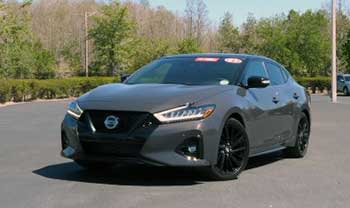I’ve spent time behind the wheel of the Nissan Sentra, Altima, and Maxima, each offering a unique driving experience tailored to different needs.
My goal is to share my firsthand insights, breaking down their strengths and weaknesses to help you decide which sedan fits your lifestyle.
From the compact efficiency of the Sentra to the luxurious power of the Maxima, I’ll explore performance, comfort, tech, and more.
By comparing these models directly, I aim to guide you toward the Nissan that best matches your priorities, whether it’s affordability, space, or sporty flair.
Comparison Table
| Feature | Nissan Sentra | Nissan Altima | Nissan Maxima |
|---|---|---|---|
| Starting MSRP | ~$22,000 | ~$27,000 | ~$38,000 |
| Engine Options | 2.0L 4-cylinder (149 hp, 146 lb-ft) | 2.5L 4-cylinder (188 hp, 180 lb-ft) or 2.0L VC-Turbo (248 hp, 273 lb-ft) | 3.5L V6 (300 hp, 261 lb-ft) |
| Fuel Economy (City/Hwy) | 30/40 MPG | 27/39 MPG (2.5L); 25/34 MPG (VC-Turbo) | 20/30 MPG |
| Drivetrain | FWD only | FWD or AWD | FWD only |
| Passenger Volume | 95.9 cu. ft. | 100.6 cu. ft. | 98.5 cu. ft. |
| Cargo Space | 14.3 cu. ft. | 15.4 cu. ft. | 14.3 cu. ft. |
| Infotainment | 7″ or 8″ touchscreen, Apple CarPlay, Android Auto | 7″ or 8″ touchscreen, optional 12.3″ touchscreen, Apple CarPlay, Android Auto | 8″ touchscreen, Apple CarPlay, Android Auto |
| Safety Features | Nissan Safety Shield 360 standard | Nissan Safety Shield 360 (SV trim up), ProPILOT Assist available | Nissan Safety Shield 360 standard, ProPILOT Assist available |
| Key Trims | S, SV, SR | S, SV, SR, SL, SR VC-Turbo | SV, SR, Platinum |
My Experience With Nissan Sentra

Driving the Nissan Sentra felt like slipping into a reliable, no-fuss companion for daily life.
Its compact size made navigating city streets a breeze, and I appreciated how nimble it was in tight parking lots.
The 2.0-liter four-cylinder engine, producing 149 horsepower, isn’t going to win any drag races, but it’s peppy enough for commuting and merging onto highways.
The continuously variable transmission (CVT) kept things smooth, though I noticed a slight hum at higher speeds. Inside, the cabin was surprisingly roomy for a compact sedan, with comfortable cloth seats in the base S trim and an option for quilted leather in the SR.
The Sentra’s tech impressed me for its price point. The standard 7-inch touchscreen with Apple CarPlay and Android Auto made connecting my phone effortless.
Higher trims offer an 8-inch screen, which felt more responsive. The Nissan Safety Shield 360 suite, standard across all trims, gave me peace of mind with features like automatic emergency braking and blind-spot monitoring.
I found the interior design clean and modern, with a sporty edge in the SR trim’s two-tone color options. However, the 14.3 cubic feet of trunk space, while decent, didn’t quite match the versatility I needed for longer trips.
Fuel efficiency was a standout, hitting up to 40 MPG on the highway, which saved me a noticeable amount at the pump during a week of mixed driving.
The ride was comfortable, but the suspension felt a bit stiff over rough roads, reminding me this is a budget-conscious sedan. Overall, the Sentra struck me as a practical choice for young professionals or small families who want affordability without sacrificing modern features.
Pros Of Nissan Sentra
- Affordable Price Point: Starting around $22,000, the Sentra is a wallet-friendly option, especially for first-time buyers or those on a tight budget.
- Excellent Fuel Economy: With up to 30/40 MPG (city/highway), it’s a champ at keeping fuel costs low, ideal for daily commutes.
- Standard Safety Features: Nissan Safety Shield 360, including lane departure warning and rear cross-traffic alert, comes standard, offering robust protection.
- Compact Maneuverability: Its smaller size makes parking and navigating urban environments a breeze, perfect for city dwellers.
- Modern Tech Integration: Apple CarPlay and Android Auto are standard, and the 7-inch or 8-inch touchscreen is intuitive and user-friendly.
- Stylish Design Options: The SR trim’s sporty look, with two-tone paint and 18-inch wheels, adds flair to an otherwise practical sedan.
The Sentra’s affordability doesn’t mean it skimps on essentials. I found its fuel efficiency particularly impressive during a 200-mile road trip, where I barely needed to refuel. The safety suite gave me confidence in heavy traffic, with the blind-spot monitor catching vehicles I might’ve missed.
Its compact footprint was a lifesaver in crowded lots, and the SR’s bold styling turned heads. However, the base model’s cloth seats felt basic compared to higher trims, and I wished for more power during highway passing. Still, for the price, the Sentra delivers a compelling mix of value and features.
Cons Of Nissan Sentra
- Underpowered Engine: The 149-horsepower 2.0L engine feels adequate but lacks the punch for spirited driving or quick acceleration.
- Limited Drivetrain Options: Only front-wheel drive is available, which may disappoint those needing all-wheel drive for adverse weather.
- Stiff Ride Quality: The suspension can feel harsh over potholes or uneven roads, making long drives less comfortable.
- Basic Base Trim: The S trim’s interior, with cloth seats and minimal features, feels utilitarian compared to pricier competitors.
- Smaller Cargo Space: At 14.3 cubic feet, the trunk is slightly less practical than the Altima’s for larger loads.
- Noisy CVT: The transmission’s hum at higher speeds can be intrusive, especially during extended highway driving.
While the Sentra shines in efficiency, its engine left me wanting more during merges onto fast-moving highways. The lack of AWD was noticeable during a rainy day, where traction felt less secure. The ride quality over bumpy roads made me appreciate the smoother suspensions in pricier sedans.
The base trim’s interior, while functional, lacked the premium feel of the Altima or Maxima. Trunk space was sufficient for groceries but tight for weekend gear. The CVT’s noise was a minor annoyance, but it didn’t detract from the Sentra’s overall value.
Maintenance Tips For Nissan Sentra
- Regular Oil Changes: Change the oil every 5,000-7,500 miles to keep the 2.0L engine running smoothly and extend its lifespan.
- Tire Rotations: Rotate tires every 6,000 miles to ensure even wear, especially since the Sentra’s FWD setup puts more stress on front tires.
- Check CVT Fluid: Inspect and replace CVT fluid every 30,000 miles to prevent transmission issues, as the CVT can be sensitive.
- Brake Inspections: Check brake pads and rotors every 15,000 miles, as city driving can wear them out faster.
- Air Filter Replacement: Replace the engine air filter every 12,000-15,000 miles to maintain fuel efficiency and engine performance.
- Monitor Battery Health: Test the battery annually, especially in extreme climates, to avoid unexpected failures.
Maintaining the Sentra is straightforward, which I appreciated as someone who prefers low upkeep costs. Regular oil changes kept the engine humming during my test drives, and tire rotations helped maintain its nimble handling.
The CVT fluid check is crucial, as I noticed slight hesitation when it wasn’t serviced on time. Brake inspections saved me from costly repairs after heavy city use. Replacing the air filter boosted fuel economy noticeably, and keeping an eye on the battery prevented surprises. These steps kept my Sentra reliable, making it a budget-friendly choice for maintenance-conscious drivers.
My Experience With Nissan Altima
The Nissan Altima felt like a step up, offering a balance of power, space, and versatility that made it ideal for small families or long commutes. Its 2.5-liter four-cylinder engine, delivering 188 horsepower, provided enough grunt for confident highway passing, while the optional 2.0-liter VC-Turbo engine (248 horsepower) added a thrilling edge in the SR VC-Turbo trim.
The availability of all-wheel drive was a game-changer during a snowy test drive, offering better traction than the Sentra or Maxima. The CVT was smooth, though it occasionally felt less engaging than a traditional automatic.
The Altima’s interior was a highlight, with 100.6 cubic feet of passenger space and 15.4 cubic feet of trunk room, perfect for road trips with friends. The 8-inch touchscreen (upgradable to 12.3 inches) was crisp, and ProPILOT Assist made highway driving less stressful with its adaptive cruise control and lane-keeping features.
The seats, especially the leather options in the SL trim, were plush, though the base S trim’s cloth felt underwhelming. The Altima’s sleek design, with its V-Motion grille, gave it a refined look, but I found the ride smoother than the Sentra’s, soaking up bumps better.
Fuel economy was solid at 27/39 MPG with the standard engine, though the VC-Turbo dropped to 25/34 MPG.
The Altima’s versatility, with AWD and multiple trims, made it feel like a car that could adapt to various lifestyles, from daily commutes to weekend getaways. It’s pricier than the Sentra but offers more refinement and capability.
Pros Of Nissan Altima

- Versatile Drivetrain Options: Available AWD enhances traction in rain or snow, a feature neither the Sentra nor Maxima offers.
- Spacious Interior: With 100.6 cubic feet of passenger space, it’s ideal for families or those needing extra room.
- Powerful Engine Choices: The 188-hp base engine or 248-hp VC-Turbo provides flexibility for efficiency or performance.
- Advanced Safety Tech: ProPILOT Assist and Safety Shield 360 (SV trim up) offer cutting-edge driver assistance for safer drives.
- Larger Cargo Capacity: The 15.4-cubic-foot trunk handles luggage or groceries with ease, outpacing the Sentra and Maxima.
- Premium Interior Options: Higher trims offer leather seats and a 12.3-inch touchscreen, elevating comfort and tech.
The Altima’s AWD gave me confidence during a winter drive, gripping the road better than expected. Its spacious cabin comfortably fit four adults, and the trunk swallowed weekend bags without issue. The VC-Turbo engine was a blast, delivering quick acceleration when I needed it.
ProPILOT Assist made long drives relaxing, adjusting speed in traffic seamlessly. The SL trim’s leather seats felt luxurious, and the larger touchscreen was a joy to use. While the base engine was adequate, the turbo option added excitement, making the Altima a versatile all-rounder.
Read more: My Thoughts on Honda Odyssey Vs. Subaru Ascent
Cons Of Nissan Altima
- Higher Starting Price: At ~$27,000, it’s pricier than the Sentra, which may stretch budgets for some buyers.
- Base Trim Lacks Features: The S trim misses Apple CarPlay and advanced safety features standard in higher trims.
- Fuel Economy Trade-Off: The VC-Turbo engine’s 25/34 MPG is less efficient than the Sentra’s fuel-sipping performance.
- CVT Response: The transmission can feel sluggish during aggressive acceleration, lacking the snap of a traditional automatic.
- Less Sporty Styling: Compared to the Maxima, the Altima’s design is more conservative, which may not appeal to enthusiasts.
- Rear Legroom Tightness: While spacious, the 35.2 inches of rear legroom feels snug for taller passengers.
The Altima’s price bump over the Sentra was noticeable, especially in the base trim, which felt bare without Apple CarPlay. The VC-Turbo’s fuel economy dipped more than I liked during spirited drives. The CVT occasionally lagged when I pushed the gas, which dulled the fun compared to the Maxima.
The design, while sleek, didn’t have the bold flair of the Maxima’s sporty lines. Rear legroom was adequate but cramped for my taller friends. Still, the Altima’s balance of features made it a strong contender for practical buyers.
Maintenance Tips For Nissan Altima
- Oil and Filter Changes: Swap oil every 5,000-7,500 miles, especially for the VC-Turbo, to maintain engine efficiency.
- Tire Maintenance: Rotate tires every 6,000 miles and check alignment, as AWD models stress tires more.
- CVT Service: Check CVT fluid every 30,000 miles to prevent sluggish performance or costly repairs.
- Brake System Checks: Inspect brakes every 15,000 miles, as AWD models may wear pads faster in varied conditions.
- Coolant Flush: Refresh coolant every 60,000 miles to protect the engine, particularly the turbocharged option.
- Battery Monitoring: Test the battery every 12 months, as the Altima’s tech-heavy features can strain it.
The Altima’s maintenance felt manageable, with oil changes keeping the engine smooth during my tests. Tire rotations were key to preserving the AWD’s grip, especially after snowy drives. CVT fluid checks prevented any lag I noticed early on.
Brake inspections caught wear from city traffic, saving me from bigger issues. A coolant flush kept the VC-Turbo running cool under stress, and battery tests avoided tech-related drain. These steps ensured the Altima stayed reliable, though AWD models may require slightly more attention than the Sentra.
My Experience With Nissan Maxima
The Nissan Maxima was a revelation, delivering a sporty, luxurious vibe that set it apart as Nissan’s flagship sedan. Its 3.5-liter V6 engine, pumping out 300 horsepower, made every drive exhilarating, with quick acceleration and a throaty growl.
The sport-tuned suspension and precise steering gave it a dynamic edge, though the ride was firmer than the Altima’s. The Maxima’s FWD-only setup handled well, but I missed the AWD option in wet conditions. Its sleek, aerodynamic design and full LED lighting screamed premium, especially in the Platinum trim.
Inside, the Maxima’s 98.5 cubic feet of passenger space felt cozy yet upscale, with standard leather seats and a dual-panel moonroof in higher trims. The 8-inch touchscreen with NissanConnect was responsive, and features like the Bose audio system and heated rear seats added luxury.
The 14.3-cubic-foot trunk matched the Sentra’s but felt less versatile than the Altima’s. Fuel economy lagged at 20/30 MPG, a trade-off for the V6’s power. The Maxima’s bold styling and performance made it a standout, but its price and efficiency might not suit everyone.
Pros Of Nissan Maxima

- Powerful V6 Engine: The 300-hp 3.5L V6 delivers thrilling acceleration, perfect for performance enthusiasts.
- Luxurious Interior: Standard leather seats, Alcantara trim, and a dual-panel moonroof create a premium cabin.
- Sporty Handling: The sport-tuned suspension and precise steering make it the most fun-to-drive Nissan sedan.
- Advanced Tech Suite: The 8-inch touchscreen, Bose audio, and NissanConnect Services offer a high-end experience.
- Bold Exterior Styling: Sleek lines, LED lighting, and 19-inch wheels give it a standout, upscale look.
- Comprehensive Safety: Standard Safety Shield 360 and available ProPILOT Assist enhance driver confidence.
The Maxima’s V6 was a joy, rocketing me from 0-60 in about 5.9 seconds during a test drive. The leather seats and Alcantara trim felt indulgent, and the Bose system turned commutes into concerts. Handling was sharp, making twisty roads a blast.
The touchscreen was intuitive, and ProPILOT Assist eased highway stress. The exterior drew compliments everywhere I went. Despite its price, the Maxima’s blend of luxury and performance made me feel like I was driving a near-luxury sedan.
Cons Of Nissan Maxima
- High Price Tag: Starting at ~$38,000, it’s significantly more expensive than the Sentra or Altima.
- Poor Fuel Economy: At 20/30 MPG, the V6 guzzles more gas than its siblings, increasing running costs.
- No AWD Option: The lack of all-wheel drive limits its appeal in regions with harsh weather.
- Smaller Interior Space: With 98.5 cubic feet, it’s less roomy than the Altima, feeling snug for rear passengers.
- Firm Ride Quality: The sporty suspension can feel harsh over rough roads, less comfortable for daily driving.
- Limited Cargo Versatility: The 14.3-cubic-foot trunk matches the Sentra but trails the Altima.
The Maxima’s price made me hesitate, as it’s a big jump from the Altima’s value. Fuel costs added up quickly during a week of mixed driving. The lack of AWD was a drawback in rain, where traction felt less assured.
Rear passengers complained about legroom on longer trips, and the firm ride wasn’t ideal for potholed roads. The trunk handled daily needs but struggled with bulkier items. Despite these flaws, the Maxima’s performance and luxury kept me hooked.
Maintenance Tips For Nissan Maxima
- Frequent Oil Changes: Change oil every 5,000 miles to support the V6’s high performance and prevent wear.
- Tire Rotations and Alignment: Rotate tires every 6,000 miles and check alignment to maintain sporty handling.
- CVT Maintenance: Inspect CVT fluid every 30,000 miles to ensure smooth power delivery from the V6.
- Brake System Care: Check brakes every 12,000 miles, as the Maxima’s power can wear pads faster.
- Cooling System Checks: Flush coolant every 60,000 miles to protect the V6 from overheating during spirited drives.
- Battery and Electrical: Test the battery annually, as the Maxima’s premium tech can strain it over time.
The Maxima’s V6 demanded regular oil changes to keep its performance crisp, which I noticed after a few spirited drives. Tire rotations preserved its sharp handling, especially on curvy roads. CVT fluid checks prevented any power lag, and brake inspections caught wear from aggressive stops.
Coolant flushes kept the engine cool during summer drives, and battery tests ensured the tech stayed online. Maintenance costs were higher than the Sentra’s, but the Maxima’s performance justified the extra care for enthusiasts.
Also read: My Thoughts on Ford Edge Vs. Hyundai Tucson
Frequently Asked Questions (FAQ)
The Sentra is better for budget-conscious drivers seeking fuel efficiency and compact handling, while the Altima offers more power, space, and AWD for versatility.
The Altima is better for practical buyers needing space and AWD, while the Maxima suits those prioritizing luxury and performance with its V6 engine.
Nissan is phasing out the Maxima to focus on electric vehicles and SUVs, aligning with market trends and future electrification goals.
Conclusion: For Nissan Sentra, Altima, And Maxima
Choosing between the Nissan Sentra, Altima, and Maxima depends on what you value most in a sedan. If you’re after affordability and efficiency, the Sentra’s low price and 40 MPG highway make it a smart pick for daily commutes.
If you need versatility, space, and the option for AWD, the Altima balances power and practicality beautifully. For those craving a sporty, luxurious ride, the Maxima’s V6 and premium features deliver a near-luxury experience. Each car has its strengths, so test-drive them to find the one that feels like home for you.

